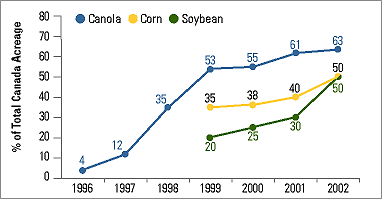An
article from the Council for
Biotechnology Information
Farmers have embraced biotechnology because it allows them to
preserve soil moisture and reduce erosion.
Ravaged by drought in the summer
of 2002, many western Canadian growers struggled to maintain
their crops in soil with little moisture. However, growers who
chose to plant biotech crops, particularly herbicide tolerant
(HT) varieties of canola, had a saving grace amongst harsh
conditions.
Herbicide tolerance allows
growers to reduce herbicide applications, but also to utilize
no-till
planting techniques - a practice that preserves the topsoil
and soil nutrients1. Moisture loss and erosion are
thus prevented, holding the soil in place unlike the drought
conditions of the dirty '30s.
"Herbicide tolerant crops played
a role in preventing yield losses last summer," says Peter
Gamache, professional agrologist and team leader for the Alberta
Reduced Tillage Linkages program. "They added great value,
enabling growers to take tillage passes out of the system,
saving moisture."
It's benefits such as these that
have accelerated adoption of biotech crops among
growers
across Canada. Since their commercial introduction in 1996,
Canadian growers have been embracing biotech canola, corn and
soybeans at a near double-digit pace annually2.
According to a January 2003
report
from the International Service for the Acquisition of
Agri-Biotech Applications (ISAAA), national acreage of biotech
crops has risen from a few trial plot hectares in 1995 to 3.5
million commercial hectares in 2002. Since 1999 alone,
plantings of biotech varieties of canola have increased by
nearly 30 percent, and biotech corn and soybean plantings have
increased by five and 15 percent, respectively3.

"The increase in the number of
growers using biotech seed is a direct reflection on the
benefits associated with growing them," says Brenda Cassidy,
director of communications for the Ontario Corn Growers
Association. "Growers are obviously seeing direct advantages."
Besides
reduced
use of herbicides and tillage, HT crops also offer more
effective weed control and a
greater
economic return. Rather than using a combination of
herbicides to control a broad spectrum of weeds, growers with HT
crops only require one herbicide — saving time, money, and
preventing the development of herbicide resistance, says Dave
Wilkins, communications director for the Canola Council of
Canada. With reduced tillage less fuel is required, benefiting
both growers' pocketbooks and the
environment, he says.4,5
Canola and soybeans comprise the
largest portion of HT varieties grown in Canada, accounting for
65 and 40 percent of total acreage in 2002, respectively. This
is an increase of about 5 percent for each from the previous
year. Biotech corn remained at 40 percent of national acreage
in both 2001 and 2002.
The slower increase in adopting
biotech corn is related to its purpose in the field, explains
Cassidy. Although herbicide-tolerant corn varieties exist, the
greatest benefit is with pest-resistant varieties containing
Bacillus thuringiensis, a naturally occurring soil bacterium
that wards off the European corn borer.
Bt corn, as it's commonly
known,
saves growers from losing part of their crop to the
stalk-ravaging pest, increasing yields and reducing the need for
pesticides. However, plantings of Bt corn vary from year
to year, depending on the estimated threat of corn borer
infestation, says Cassidy.
As of 2002, Canada ranks third
among the top four leading countries growing biotech crops,
contributing 3.5 million hectares of the global production total
of 58.7 million hectares. Canada shares global production with
the United States (39 million hectares), Argentina (13.5 million
hectares) and China (2.1 million hectares)6.
Other nations, particularly
developing ones, are starting to reap the benefits of biotech
crops. According to an ISAAA report, 2002 marked the first
plantings of crops enhanced through biotechnology for India,
Colombia (Bt cotton) and Honduras (Bt corn). The Philippines
became the first Asian country to approve a biotech feed crop,
allowing the planting of a variety of Bt corn.
"Biotechnology continues to be
the most rapidly adopted technology in agricultural history due
to the social and economic benefits the crops offer farmers and
society, particularly the 5 million resource-poor farmers in
developing countries," says Clive James, chairman and founder of
ISAAA. "Biotech crops can significantly alter the lives of these
farmers, limiting the time they must spend in the field and
helping alleviate poverty."
The ISAAA report projects
continued near-term growth in global acreage of biotech crops
and in the number of farmers who will use the technology. New
biotech cotton and corn products are expected to be
commercialized within the next few years as well, further
increasing biotechnology's presence around the world. By 2005,
the report predicts the global market value of biotech crops
will reach $5 billion, up from approximately $4.25 billion in
2002 and $3.8 billion just a year before.